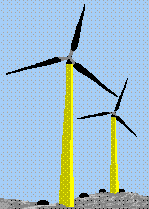
| |
 |
![]()
An article called Harnessing the Wind on page 78 of the November, 1995 issue of IEEE Spectrum magazine describes how wind mills are successfully competing with traditional power sources around the world. The extensive and highly technical article, by Jay Jayadev of R. Lynette & Associates, gives case histories detailing wind mill installations in third world countries.
Only fairly recently has wind power been recognized as the one renewable energy source that will be economically viable in the near future. The Electric Power Research Institute (ERPI), in Palo Alto, Calif., which represents cooperative R&D interests of the U.S. utility industry, stated in a 1992 report: "Alone among the alternative energy technologies, wind power offers utilities with good wind resources, pollution free electricity that is nearly cost-competitive with today's conventional sources."
Since then, several wind power projects from Antarctica and Mexico to India and Indonesia have shown how practical its use can be. Not only is the power supply reliable and easily maintained, but it can also be more competitive in the long run than traditional, more heavily polluting alternatives.
In the case of either horizontal or vertical axis turbines, good-quality electricity can be generated by two methods. In the well-established approach, induction generators are connected to the grid, resulting in the turbine's being mechanically constrained to a very narrow speed range and therefore producing a constant-frequency output suitable for pumping power to the grid. That means when high velocities or gusts of wind try to speed up the rotation of the shaft, the extra torque must be absorbed by the drive train and the tower. This approach causes torsional stresses on the mechanical parts and also wastes wind energy (although often the pitch of the rotor blades can be changed to reduce stress during high winds).

A newer approach, made feasible by advances in power semiconductors, is to allow the turbine speed to vary and then eliminate the fluctuations in amplitude and frequency electronically. By letting the generator speed up during gusts and sustained high winds, this approach both increases the amount of electricity generated and reduces the stresses on the drivetrain.
In general, such technology as high-efficiency blades and generators, along with power electronics for variable-speed drives, has contributed to reducing the cost of wind energy. Wind turbines can produce electricity at $0.05kWh at a good wind site, with an average wind speed of greater than 5 meters per second.
But in any situation, the fickleness of the wind must be considered. According to the American Wind Energy Association, most modern wind farms operate with a capacity factor of 25-35 percent - that is, the actual power produced over time as compared to the theoretical production of the turbines operating at maximum output 100 percent of the time. (Conventional power plants typically operate at 40-80 percent capacity factors.)
To supply villages with electricity, it is often more feasible to give them an independent source of power than to invest in transmission lines to connect them to the utility grid. ... Stand-alone installations are appropriate technologies for such applications. Because storage is a necessity in these isolated systems, they are technically more challenging to design and more expensive than are grid- connected generators that simply augment existing power infrastructures. To boost overall reliability of the electricity supply, engineers can design systems that tie isolated wind machines to other types of generators. These hybrid systems often combine a wind turbine, a battery bank, and a diesel-powered backup generator.
Wind rotors in small turbines spin 100-300 or so revolutions per minute. Large turbines intended for grid interconnection spin about 30-60 revolutions a minute and sometimes even more slowly. In small systems, direct drive is preferred to geared drive for its higher reliability. Any standard off-the- shelf generator can be used with a speed-increasing gear, but reliability is reduced. As a result, manufacturers of small turbine systems develop their own custom generators, and couple them directly to the wind rotor. For example, in a machine developed by wind turbine manufacturer Bergey Windpower Co., Norman, Okla., a permanent-magnet ring is directly attached to the wind rotor, which envelops and rotates about the station.
In designing stand-alone systems, engineers can choose from several options. Usually the systems operate in a variable-speed mode. To generate clean constant-amplitude, constant-frequency electricity, they therefore require a rectifier-inverter combination. For dc loads, of course, only the rectifier is needed. Generally, the average load is greater than 25 kW or so, using a single medium-sized turbine rather than several small ones is better - as long as the logistics are practical. For example, if a village requires 100 kW, and there is good access to the site, a medium-sized machine would be a good choice. Energy from these machines costs a half to a third of that from an array of small machines.
Small wind turbines usually have alternators with permanent magnet excitation. They produce power according to wind speed, reaching maximum power at 12 meters per second. Modern small wind machines have achieved a high level of integration and simplicity, and have proved that they can work well in the field under extreme conditions. Bergey Windpower, for example, integrates the rotor and the hub into one component and the stator and the main frame into another, thus reducing the number of parts and boosting reliability.